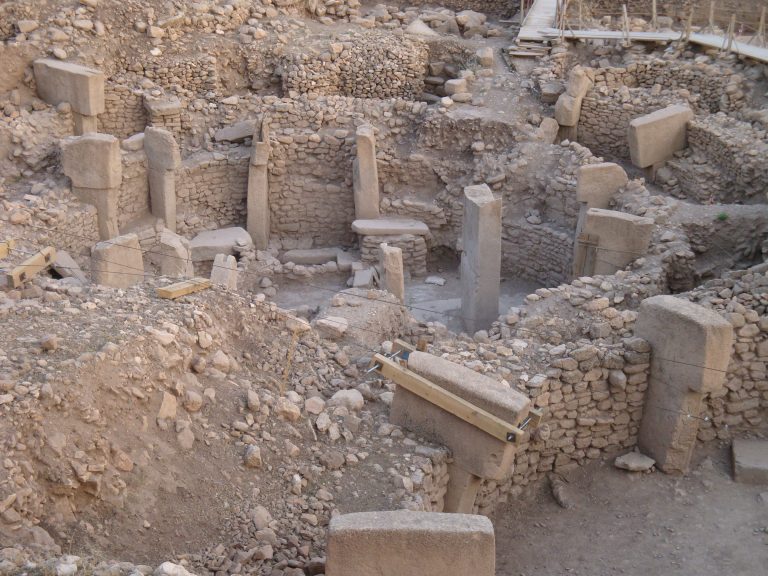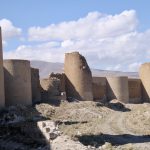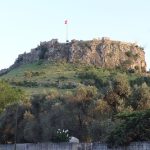The Hittites, the Phrygians, the Urartians. Turkey’s most famous archaeological sites tend to be those dating back to the Graeco-Roman period. However, some of the most historically important of them pre-date the Graeco-Romans, often by many centuries. The country is littered with remains attributed to groups such as the Hittites. The trouble is that some of the sites make strenuous demands on the visitor, asking them to imagine what life might have been like there from little more than holes in the ground or low-level stretches of wall. Then there are the sites such as Troy that don’t quite live up to advance billing, and others such as Aizanoi and Dara that are just too out of the way to catch much passing trade, despite their considerable importance.
Göbeklitepe
These days most of the buzz around Turkey’s pre-Roman archaeological sites is focussed on Göbeklitepe, near Şanlıurfa in the south-east of the country. This astonishing site in the middle of nowhere appears to have consisted of a series of circular temples filled with T-shaped pillars, some of them carved with arms and hands, others decorated with images of animals. No evidence of a settlement was initially found near the site and the undamaged state of the pillars seemed to suggest that the temples were deliberately covered up some 10,000 years ago. However, recent work at the site suggests that soil slippage could account for the burial of the pillars.
Excavation work in the area has accelerated since 2014, resulting in the discovery of many other sites featuring the same T-shaped pillars at Ayanlar Höyük, Hamzan Tepe, Harbetsuvan Tepe Karahantepe, Kurt Tepe, Nevalı Çori, Sayburç, Sefer Tepe, Taşlı Tepe and in the Yeni Mahalle of Şanlıurfa, known collectively as the Taş Tepeler (Stone Hills). Protected by a shelter, Göbeklitepe is now a UNESCO world heritage site.
Troy
Ephesus may be Turkey`s biggest and most impressive set of ruins but the best known of its archaeological sites has to be Troy, the North Aegean town that provided the setting for the 10-year-long Trojan War described by Homer in The Iliad. Troy’s exact location might have remained a mystery had it not been for the determined efforts of the German archaeologist Heinrich Schliemann (and the less well-known British Frank Calvert) who went to enormous lengths to track it down and then excavate it. Today’s visitors tend to have mixed feelings about the site. The romantics gaze out over the surrounding Troad and try to imagine Achilles, Ajax and Hector doing battle for the honour of Helen, the most beautiful woman in the world. The non-romantics are mostly sniffy about a complicated site on multiple levels which lacks the drama of Ephesus. Regardless, their children usually love the replica Trojan horse which stands near the entrance.
Çatalhöyük
If the remains at Troy can seem disappointingly slight, those at Çatalhöyük near Konya are even more so, yet historically they are of extraordinary importance. For a long time it was believed that this was one of the oldest towns ever to have existed, and although recent discoveries have put paid to that idea, still many people are enthralled to realise that they are looking at the remains of houses that were lived in more than 9,000 years ago. Lingering memories of the Neolithic cult of the Mother Goddess also appeal to many contemporary visitors. The biggest problem used to be getting to the site without your own wheels although there is now a bus service from Konya. Alternatively there are infrequent buses from Konya to Çumra where you can hire a taxi to the site or to Kükköy whence you can approach the site on foot.
Sardis
Not to be confused with the Lycians, the Lydians were a people who occupied much of the Aegean hinterland some 2,500 years ago and are credited with the invention of coinage. Sardis, inland from İzmir near Sart, was their capital where the fabulously wealthy King Croesus held court, although today the remains are mainly of the Graeco-Roman city that developed there after most of the older city was laid low by an earthquake in 17 AD. The most impressive structure is the reconstructed Marble Court of the Hall of the Imperial Court but you`ll also find remains of an ancient synagogue here along with traces of shops and a temple of Artemis. If only Ephesus wasn’t quite so near at hand it would undoubtedly attract many more visitors.
Aizanoi
The Roman ruins of Aizanoi are scattered about the village of Çavdarhisar, south-west of Kütahya. Really they deserve to be thronged with visitors not least because there are substantial remains of a Temple to Zeus as well as of a stadium and a unique circular market building with the prices of various items still listed on the walls. So why do so few people drop by? Well, the name doesn’t exactly trip off the tongue, does it? Besides, most visitors are just too distracted by the competing charms of the Kütahya ceramics shops.
Xanthos
The site of the Lycian town of Xanthos at Kınık on the south coast near Patara is another of Turkey’s world heritage sites, this time in combination with the nearby Letoon, the watery shrine to Leto, the mother of Apollo and Artemis. The Lycians were a people who established a network of independent city-states in Asia Minor that were slowly absorbed into the Roman Empire. Not surprisingly, then, Xanthos is home to an impressive Roman theatre as well as to several Lycian pillar tombs whose fine inscriptions and decorations were removed to the British Museum in 1842. A short uphill walk brings visitors to a Lycian necropolis full of distinctive rock-cut tombs.
Myra
Mad about the Lycians? Then a little way further east along the coast you will come to Kale/Demre, an unappealing small town best known for a church associated with the cult of St Nicholas (AKA known as Santa Claus). Inland from the tacky souvenir stalls, you’ll find the ruins of ancient Myra with a beautiful Roman theatre in a wonderful state of repair as well as another astounding Lycian necropolis that is especially photogenic.
Gordion
The Phrygians were a people who ruled over the area around what is now Ankara some 2,500 years ago. Their most famous settlement was at Gordion near Polatlı where a large burial mound was once believed to contain the remains of King Midas (he of the asses’ ears). Although this is no longer thought to be the case, the framework inside the mound is still one of the world’s oldest wooden structures. A little way further along the road lie the remains of the town of Gordion with a thoroughly impressive main gateway. Hooked on the Phyrgians? Then you might also want to make your way to Midas Şehri, a huge rock-cut tomb adorned with impressive Phrygian carvings that stands in glorious isolation at Yazılıkaya, north of Afyon.
Hattuşa
If the Phrygians can seem obscure, the same could also be said of the Hittites who ruled over large chunks of Anatolia and the Middle East some 3,500 years ago. Very little was known about them until 1834 when the French traveller, Charles Texier, stumbled upon the remains of Hattuşa, the capital first of the even more mysterious Hatti people and then of the Hittites. Today those ruins form one of Turkey’s UNESCO-recognised world heritage sites along with the associated ruins at Yazılıkaya (not to be confused with the one near Afyon) and Alaca Höyük. Until recently there were only slight ruins at Hattuşa, close to the small village of Boğazkale, but parts of the wall have been rebuilt to give visitors a better idea of what the city might have looked like in its heyday. Yazılıkaya, where they can inspect a line-up of Hittite deities carved into the rock, is within walking distance of Hattuşa. To get to Alaca Höyük requires private transport or a taxi. And if the Hittites have wormed their way under your skin then there are other striking remains to be discovered in the Karatepe-Aslantaş National Park, near Osmaniye, and at Yesemek near Gaziantep.
Van Castle
Way over on the far eastern side of Turkey it was the Urartians who ruled the roost from the 13th to seventh century BC and their most imposing memorial is the castle that bestrides a huge rock on the western side of Van. Come here to inspect extraordinary cuneiform inscriptions cut into the rock, then head straight for Van Museum to eye up some of the gorgeous gold artefacts dating back to Urartian days.


